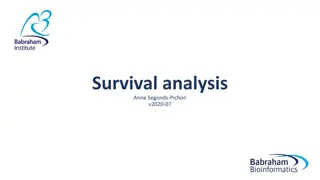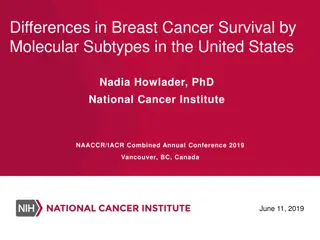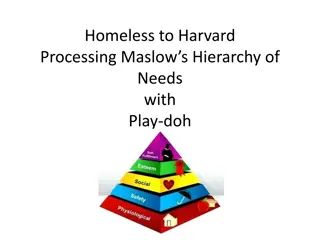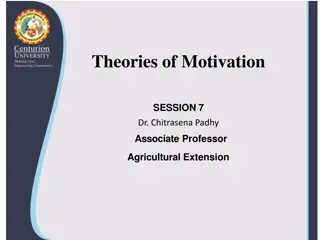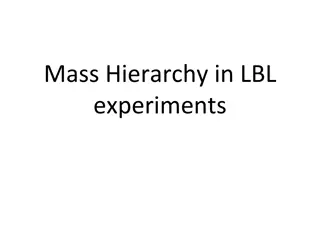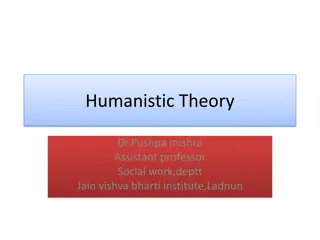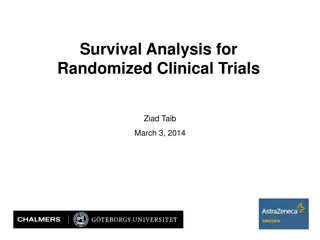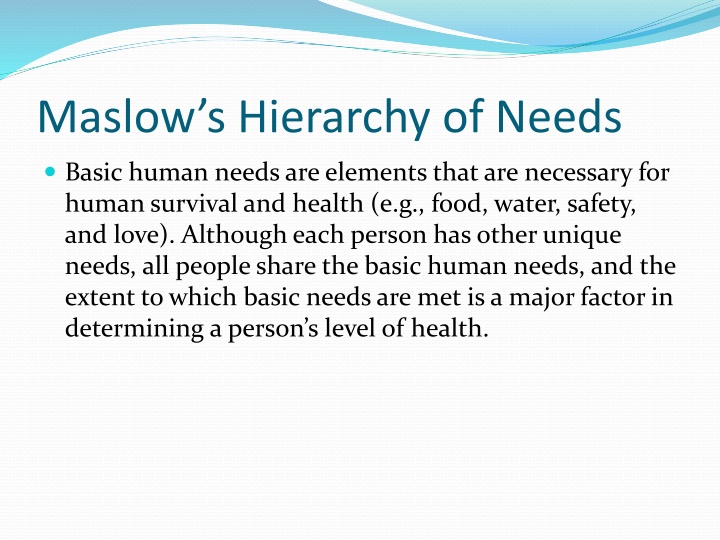
Maslow's Hierarchy of Needs: Basic Human Needs for Survival and Health
Maslow's Hierarchy of Needs outlines the fundamental elements crucial for human survival and well-being, encompassing physiological, safety, love, belonging, esteem, and self-actualization needs. This model, often used by nurses, emphasizes the prioritization of basic needs over higher-level needs in caregiving, recognizing individual experiences and unique needs. While the hierarchy provides insights into patient care, it's essential to tailor interventions based on individual circumstances rather than rigid adherence to the hierarchy order.
Download Presentation

Please find below an Image/Link to download the presentation.
The content on the website is provided AS IS for your information and personal use only. It may not be sold, licensed, or shared on other websites without obtaining consent from the author. If you encounter any issues during the download, it is possible that the publisher has removed the file from their server.
You are allowed to download the files provided on this website for personal or commercial use, subject to the condition that they are used lawfully. All files are the property of their respective owners.
The content on the website is provided AS IS for your information and personal use only. It may not be sold, licensed, or shared on other websites without obtaining consent from the author.
E N D
Presentation Transcript
Maslows Hierarchy of Needs Basic human needs are elements that are necessary for human survival and health (e.g., food, water, safety, and love). Although each person has other unique needs, all people share the basic human needs, and the extent to which basic needs are met is a major factor in determining a person s level of health.
Maslows hierarchy of needs is a model that nurses use to understand the interrelationships of basic human needs (Fig. 6-3). According to this model, certain human needs are more basic than others (i.e., some needs must be met before other needs [e.g., fulfilling the physiological needs before the needs of love and belonging]). Self- actualization is the highest expression of one s individual potential and allows for continual discovery of self. Maslow s model takes into account individual experiences, always unique to the individual
The hierarchy of needs model provides a basis for nurses to care for patients of all ages in all health settings. However, when applying the model, the focus of care is on the patient s needs rather than on strict adherence to the hierarchy. It is unrealistic to always expect a patient s basic needs to occur in the fixed hierarchical order. In all cases an emergent physiological need takes precedence over a higher-level need. In other situations a psychological or physical safety need takes priority. For example, in a house fire fear of injury and death takes priority overself-esteem issues.
Although it would seem that a patient who has just had surgery might have the strongest need for pain control in the psychosocial area, if the patient just had a mastectomy, her main need may be in the areas of love, belonging, and self-esteem. It is important not to assume the patient s needs just because other patients reacted in a certain way. Maslow s hierarchy can be very useful when applied to each patient individually. To provide the most effective care, you need to understand the relationships of different needs and the factors that determine the priorities for each patient.
Self actualization Self-esteem Love and belonging needs Safety and security(Physical safety Psychological safety) PhysiologicaL(Oxygen , Fluids , Nutrition, Body temperature, Elimination, Shelter, Sex)
Physiological needs:- Needs such as air, food, water, shelter, rest, sleep, activity, maintenance are crucial for survival. Safety and security needs:- The need for safety has both physical and psychological aspects. The person needs to feel safe, both in the physical environment and in relationships. Love and belonging needs:-The third level of needs includes giving and receiving affection, attaining a place in a group, and maintaining the feeling of belonging and temperature
Self-esteem needs:- The individual needs both self- esteem (i.e., feelings of independence, competence, and self-respect) and esteem from others (i.e., recognition, respect, and appreciation). Self-actualization:- When the need for self-esteem is satisfied, the individual strives for self-actualization, the innate need to develop one s maximum potential and realize one s abilities and qualities
Maslows Characteristics of a Self- Actualized Person Is realistic, sees life clearly, and is objective about his or her observations. Judges people correctly. Has superior perception, is more decisive. Has clear notion of right and wrong. Is usually accurate in predicting future events. Understands art, music, politics, and philosophy. Possesses humility, listens to others carefully. Is dedicated to some work, task, duty, or vocation. Is highly creative, flexible, spontaneous, courageous, and willing to make mistakes.
Is open to new ideas. Is self-confident and has self-respect. Has low degree of self-conflict; personality is integrated. Respects self, does not need fame, possesses a feeling of self-control. Is highly independent, desires privacy. Can appear remote and detached. Is friendly, loving, and governed more by inner directives than by society. Can make decisions contrary to popular opinion. Is problem centered rather than self-centered. Accepts the world for what it is.




